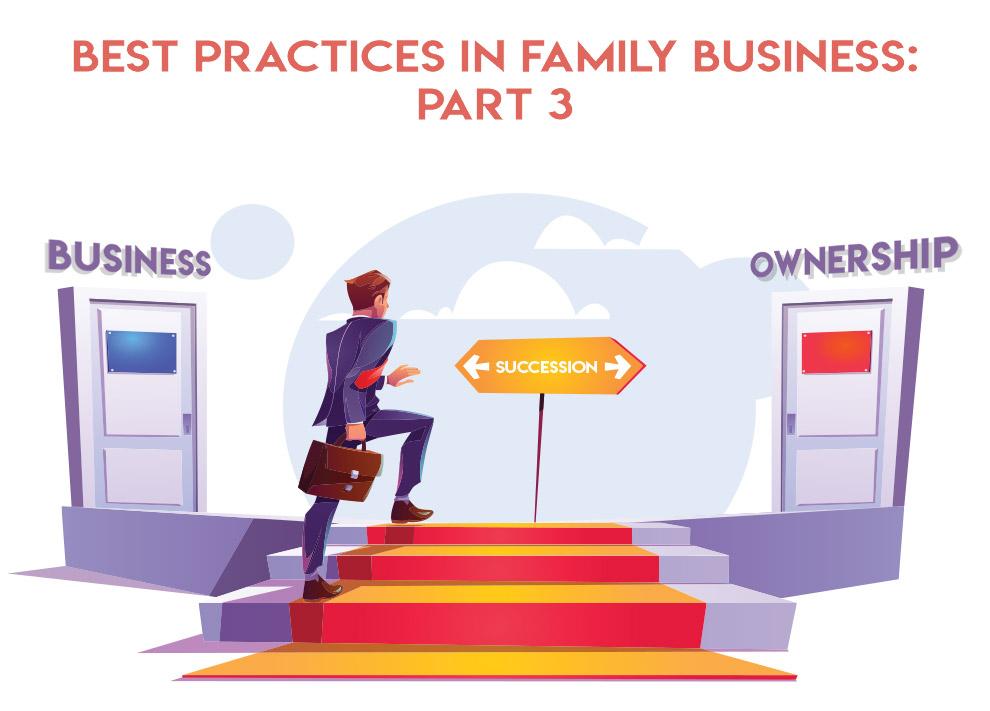
BEST PRACTICES OF FAMILIES IN BUSINESS: PART 3
In Best Practices of Families in Business: Part 1 & Part 2 of this series Aspen Associates Shelley Taylor and Jonathan Magidovitch review Best Practices for Family Business. They revisit the tried and true foundations of family business, then current management practices and here, in part three, they guide family business members to look to the future with key points on planning for Catastrophe, for Business Succession and for Ownership Succession.
Catastrophe planning
Do you have a plan for who would run the company if the leader died suddenly and documents that are readily accessible to help that person deal with the legal, financial, and operation challenges in that crisis? Have you shared the plan with key people so they will be prepared to implement it at that time (spouse, other executives, and so forth)? (chapter 12, Keys to Family Business Success)
There’s a different kind of calm available to my racing mind when I’ve dealt with the stuff I don’t want to deal with. Catastrophe planning is just such stuff. We know we have to deal with it but it’s the opposite of fun. However, our going through a few basics here will help clear a path for this work. Think of this as a warm up of our management muscles that eases us into dealing with the tough stuff of catastrophe planning.
The catastrophes we’re talking about are those things that can damage our business often in a sudden or irretrievable way. We’re talking about death or disease, divorce or dispute, acts of God such as storms, human acts such as war or sabotage. These are all extreme things which we hope never to see .. but best if we’re prepared. Catastrophe planning includes:
- Who should be contacted first once the catastrophe arises? For example, make sure your spouse knows who to call.
- Who will step in to make immediate day-to-day decisions?
- Complete, updated lists of access codes, passwords, account numbers, policy numbers, key contacts for key functions such at your IT support.
- How will stakeholders receive income during the transition?
- Where is the information kept and who has access? On and offsite data and document storage and protection.
Each of these tools requires regular updating, too. Annual checks across the entire business are worthwhile. Spot updates are called for whenever a new person occupies a position or if an owner passes away or becomes incapacitated.
We’ve already acknowledged that catastrophe planning isn’t fun. But, it’s better than facing a catastrophe without planning. Catastrophe planning can be expensive with legal fees and IT costs, but again, it’s less costly than facing those situations without the right documents or programs in place.
And, when catastrophe planning is an ongoing part of our business, we can sleep better. We may not have thought of everything; it’s likely we haven’t. Even so, there’s something very powerful about doing things that acknowledge the impermanence of every person and every situation. It tempers egos. It places us in a context, the business, that is bigger than any one of its stakeholders.
In sum, catastrophe planning is a key part of our business mindset. By doing catastrophe planning, we’re saying that everyone is both important and replaceable. Businesses that ignore human frailty are really just transferring that frailty through to the business itself, and to those who are left behind. Businesses that acknowledge the things that can and will happen to people are always stronger for it.
Succession planning
Have you considered what type of leadership will help achieve the long-term vision and who might be prepared to be a successor to the current company leader? Have you thought about the other components of succession planning and addressed those? (chapters 10 & 12, Keys to Family Business Success)
We don’t want to leave things to chance, but how do we go about making all the necessary decisions to make sure the business continues successfully? Choosing a successor is a huge decision, especially for one person to make. This is where your board and other trusted advisors can be invaluable. They should be able to provide you with unbiased and objective assessments of what the job requires. For example, you can start by looking at the vision, strategy and goals of the company. What type of leader does the business need to fulfill the vision, execute the strategy and achieve the goals in a 10 to 20 year timeframe? And what skills, attributes and characteristics should that person possess?
Once you have determined what attributes and skills are needed, then look to your pool of candidates. A board of directors can be valuable here. Impartial and experienced advisors can help with objective assessment of family members. It may sound odd to suggest to a family business that they turn to their board to help with this decision. But CEO succession is one of the primary duties of a board of directors.
This assessment of candidates and the planning that follows require time and attention well before the actual change in leadership is to take place. You may have several internal candidates whose progress you want to track. Or maybe there is one strong candidate but she could benefit from additional education or experience before assuming the top job. If there are no strong internal candidates, or there are some high potentials but none of them will be ready in time for the planned leadership transition, you may need to look outside the company. This can be scary and feel unnatural for a family business – to look outside the family (or the business) for its next leader. Yet, there are highly qualified people who “get” family business and could be just the right fit for your family and your business, and help provide a necessary bridge to the next generation of leaders.
Leadership and ownership succession are what generally come to mind when we think of succession planning. So far in this piece, we’ve been discussing leadership transition, and below we cover ownership succession. But there are additional aspects to consider beyond these two important areas. Aspen Partner Leslie Dashew has written about the Seven Dimensions of Succession – leadership ownership, management, authority, relationships, values, and knowledge. All seven come into play in succession and benefit from focused attention.
As a matter of course, and as an element of catastrophe planning, you should have a succession plan for the management roles in addition to the top position in your business. Think of it as your bench strength — you want to be constantly developing your people and identifying potential successors for key roles. And authority needs to accompany a change in roles; leadership needs to be adhered to in behavior as well as in name. We’ve all heard stories about the founder who gives the title to his son, but still makes all the decisions; or the former leader who at 85 still comes in to work everyday and it is to him that the employees go with their questions.
The relationships, values and knowledge we possess are sometimes taken for granted. To support a smooth transition it is important for the senior generation to make appropriate introductions to business partners, clients and other constituents; ensure that their successors understand and adhere to the business’ and family’s values and can articulate them; and not only impart knowledge about key elements of the business and the industry but share their wisdom and experiences as well. Two generations working alongside each other with a well-organized plan will address each of these dimensions as the family and business work toward a transition.
Ownership Succession
Have you developed estate plans to assure the company would be protected from estate tax obligations and conflict at the death of the current owner(s)? (chapter 12, Keys to Family Business Success)
The workhorses of ownership succession include:
- Buy/Sell agreements executed among the owners
- Pre and post nuptial agreements
- Appropriate insurance to provide cash for a partner buyout or repair from a destructive event
For more on these, please see our Aspen Partner William Robert’s article, Buy Sell Agreements … an often Misplaced Document.
Above, we discussed catastrophe planning. Ownership succession planning does overlap with that. Significantly though, ownership succession need not be tied to catastrophes at all. Ownership succession planning actually can prevent catastrophes or at the very least make them less disruptive.
In practice, estate plans dovetail with ownership succession. Both address what happens to company shares at key times of transition. As we covered in Part 1 of our series, estate plans that are not only well thought out, but also clearly articulated and communicated, are important for smooth and successful family business transitions.
Just as owners should understand the mechanisms for transferring shares, there shouldn’t be any secrets or surprises about a family member’s plans for her shares after she dies.
Senior family members feel they are protecting their offspring by not discussing their estate plans with them. And they don’t want to have uncomfortable or difficult conversations. Unfortunately they are putting a greater burden on the “children” by not addressing the topics while there is still time for an open and honest dialogue. Discord, jealousy, and buried feelings of resentment often surface when the children are surprised by the distribution of shares or wealth after the passing of a parent. The answers (and reassurance) they sought while the parent was alive are now only to be guessed at, and the resulting emotions get directed at their siblings.
Another aspect of ownership succession touches on the transfer of knowledge, one of the aforementioned seven dimensions of succession. Future owners should have a chance to learn what it means to be an owner. Without robust knowledge transfer, future and new owners are left to wonder what an owner can and cannot do. Am I automatically on the board? Who chooses board members anyway? Do I get to set policy and/or strategy for the business? Can I work at the business if I want (simply because I am an owner)? Rather than suddenly finding themselves as owners without a roadmap, the future owners will be prepared for their roles and can become responsible stewards of the family business.
Throughout this series we’ve covered eleven practices for family business success; we believe that if you take an active approach to your family business you are positioning yourself, your business and future generations for success.
Build a shared vision based on shared values. Create governance structures that encourage healthy communication including a Family Council or regular family meetings. Create documents that clearly describe key issues such as ownership shares and rights. Build trust among your stakeholders.
Manage your business with a healthy balance of emotion and objective performance measures. For each position create a job description. Match each element of the position with objective, measurable outcomes. Create a strategic plan that includes a realistic assessment of the assets within your family business and the potential for either organic growth or growth by acquisition.
Plan for the difficult realities of life and life’s natural transitions. It’s painful that people die or divorce or burn out but all that can be planned for. Planning doesn’t remove those issues but it certainly does reduce their negative impact. And with a plan in place, you are providing a solid foundation for the next generation of your family.
We hope this series on Best Practices for Family Business helps your family business build, run and plan more effectively. We would look forward to hearing your thoughts or further questions. From our hearts, we wish you all the best of health and happiness and family business success.
Author(s)

SHELLEY TAYLOR
Shelley Taylor is a Family Business Advisor who works with business-owning families on matters pertaining to governance, structure, role clarity, next generation development, generational transitions, and family councils. ( view bio )

JONATHAN MAGIDOVITCH
Jonathan advises family businesses in both the US and Israel. He consults with families in business on goal setting, role development, governance, communication, transition, leadership and culture building. ( view bio )

